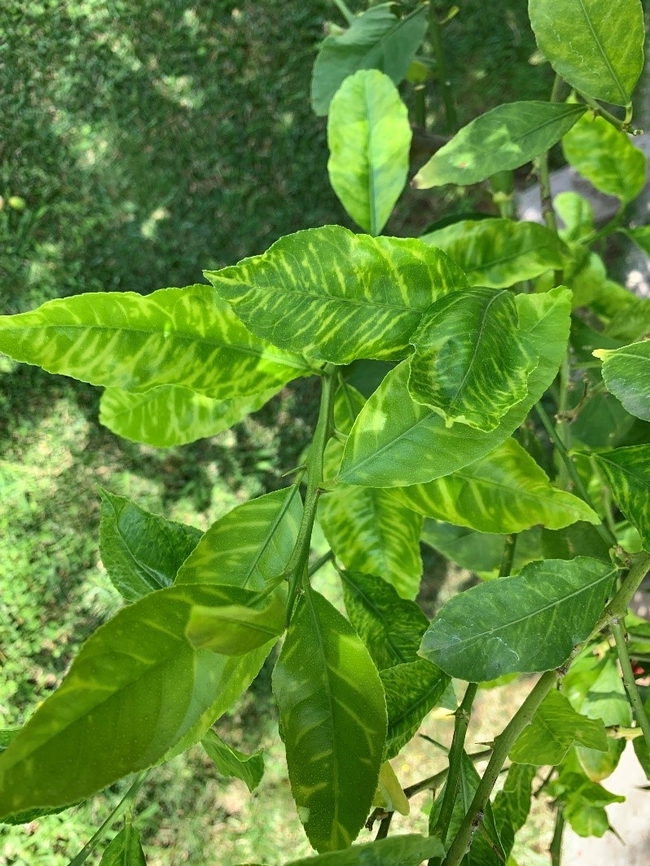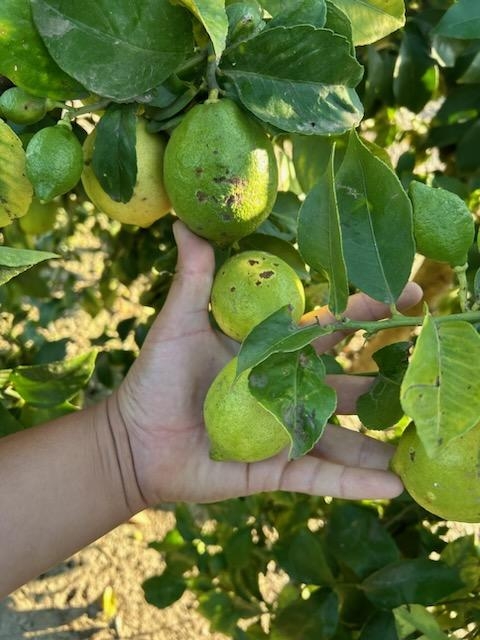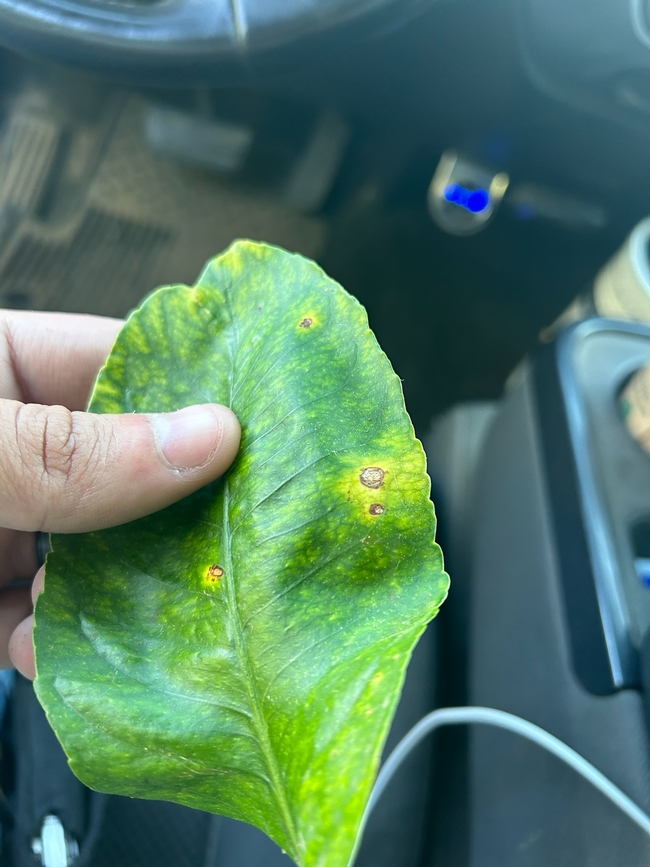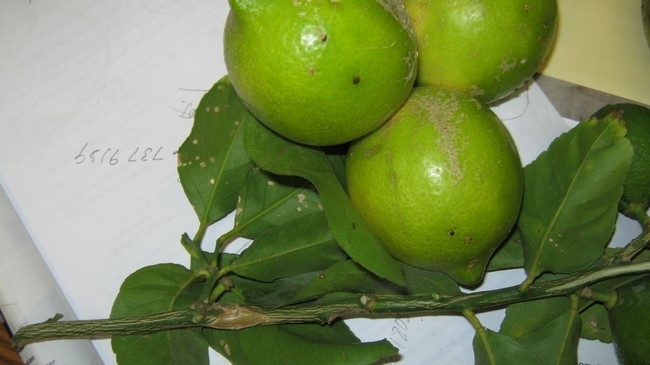- Author: Ben Faber
|
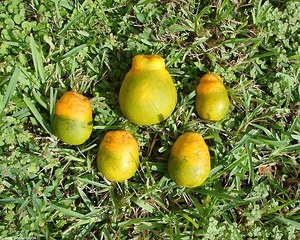
- Author: Ben Faber
So what causes these wounds on leaves and fruit on lemons? Corky, sunken blisters on the leaves. Small divots in the fruit. Some of the spots had halos around them, but most not. That would indicate an infection of some sort. It was showing up in a large orchard near Santa Paula.The growers indicated that maybe 20% of the fruit was affected.
Insects? None. Disease? Not really. More damage was on the fruit than leaves, but what would cause what looked like mechanical damage like this? Outside fruit and mostly on the outside of the outside fruit. Wind poking stems? Frost heave? Hail?
Looking round the area at other orchards, other owners, other management practices, old trees and new. The whole area had the problem and it was only on lemons. It wasn't on opuntia cactus or some nearby avocados, oleanders, or roses. But it was something real and it was something that had happened in that area. Rain. High humidity. Things we don't normally see here in the summer time. And what do we get - Edema. Cell Burst. Mesophyll Collapse.
Edema may be caused by any agent that stimulates an abnormal increase in the size and number of a group of inner cells. Edema can be induced by (1) spraying with some chemicals such as ammoniacal copper carbonate in an oil emulsion, (2) injuries resulting from wind-blown sand particles and sucking insects, (3) high light intensity, and (4) accumulation of water in the intercellular spaces.
The most common cause of edema is the presence of abundant, warm soil water and a cool, moist atmosphere. Under these conditions the roots absorb water at a rate faster than is lost through transpiration. Excess water accumulates in the leaf, some parenchyma cells enlarge and block the stomatal openings through which water vapor is normally released from the plant; thereby contributing to further water retention in the leaf. If this condition persists, the enlarged cells divide, differentiate a cork cambium, and develop elongate cork cells externally to form a periderm. The rupture of the epidermis by the enlarged inner cells and the periderm account for the raised, crusty appearance of older edema spots and also corky veins.
So what can a lemon grower do? Especially since more rain is forecast for this coming year.
1. Avoid irrigation or watering during cool, overcast humid weather. Irrigate when soils need to be watered. Avoid a fix schedule and when humidities are high.
2. Avoid overfertilizing, especially when the plants are growing slowly, such as during the winter months. Maintain fertility based on a leaf analysis. Avoid low levels of potassium and calcium.
Photo:
Early on, the black spots on the fruit start out as a clear exudate. The same for the brown spots on the leaves.
- Author: Ben Faber
UC IPM supports research and extension programs in integrated pest management (IPM). UC Agriculture and Natural Resources scientists adapt research for practical application, and Cooperative Extension advisors and specialists develop and deliver IPM programs to a variety of clientele, including professional pest managers, growers, residents, and agencies. UC IPM staff work with UC ANR scientists to develop "how-to" materials that help the clientele carry out programs and solve pest problems.
To complement the extension programs, UC IPM staff members coordinate development of a variety of materials that explain how to carry out pest management tactics and strategies. Working with UC ANR experts, program staff produce and maintain an extensive array of print and Web-based publications, databases, training materials, and interactive tools for decision making.
Examples are the pest management guidelines and a home and landscape database of pest solutions for residential audiences, IPM manuals for specific crops, books about IPM in landscapes and gardens, a variety of books on pesticide safety, and an extensive weather database that supports interactive pest models.
And now they are happy to announce the publication of a new update to the Citrus PMG. The Year-Round Program has been updated, Ants, Asian Citrus Psyllid, and Huanglongbing
And to learn more about Ant control in citrus, cherimoya and passion fruit, look into the upcoming workshops, September 19 and 21:
https://ucanr.edu/blogs/blogcore/postdetail.cfm?postnum=57442
https://ucanr.edu/blogs/blogcore/postdetail.cfm?postnum=57622
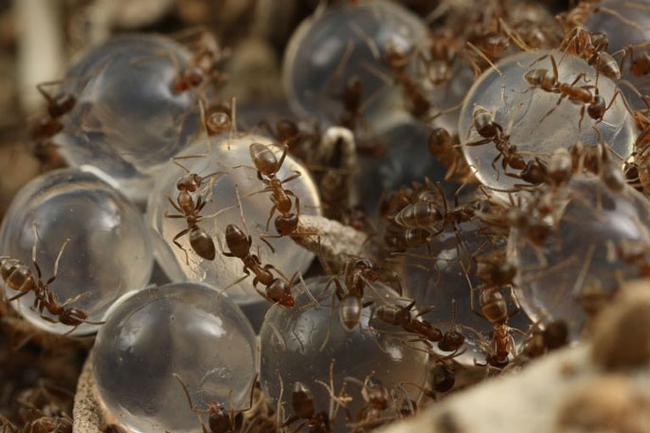
- Author: Ben Faber
|
|
|
|
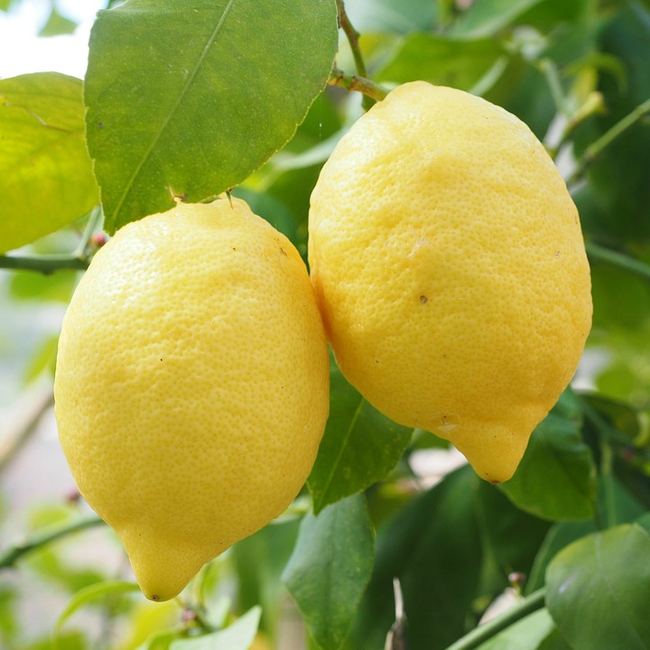
- Author: Greg Douhan and Georgios Vidalakis
The California Department of Food and Agriculture (CDFA) regularly performs surveys across the San Joaquin Valley (SJV) to monitor for potential insect and pathogen issues for California agricultural producers. In October of 2021, CDFA inspectors began performing a multi pest survey for citrus in addition to the routine inspections for the Asian citrus psyllid and Huanglongbing in residential properties. In March of 2022, a surveyor came across some unique leaf symptoms on a residential lemon tree in the city of Tulare, CA. Samples from the initial find in Tulare County were sent to CDFA's Plant Pest Diagnostic Center in Sacramento, California (https://www.cdfa.ca.gov/plant/PPD/) and tested positive for the citrus yellow vein clearing virus (CYVCV), a putative new member of the genus Mandarivirus associated with the yellow vein clearing disease of citrus. This result was subsequently confirmed by the United States Department of Agriculture, Plant Pathogen Confirmatory Diagnostics Laboratory (https://www.aphis.usda.gov/aphis/ourfocus/planthealth/ppq-program-overview/science-technology/plant-pathogen-confirmatory-diagnostics-laboratory).
After consulting with the United States Department of Agriculture regarding sampling strategies, delimitation surveys are continuing to determine the extent and distribution of CYVCV in California. Once a positive tree has been identified, CDFA returns to the property and surveys all citrus trees within a 1-mile delimitation radius around the detection, additionally CDFA conducts delimitation surveys in arcs around the delimitation core. Around the initial detection core in the city of Tulare, CDFA has already conducted 7-mile and 6-mile arcs and around the new core CDFA is conducting a 4-mile arc delimitation survey. All samples are sent to CDFA's Plant Pest Diagnostic Center for molecular testing. A total of 578 trees have tested positive so far for CYVCV in the city of Tulare and recently two trees tested positive in the city of Visalia, but no findings in commercial citrus groves in the SJV have been reported thus far.
Symptoms of CYVCV disease include vein clearing when viewed from the top of the leaves and water soaking when viewed from the bottom of the leaves. Symptomatic leaves may also be curly or have some crinkling. Researchers from other parts of the world have reported that the virus is vectored by the citrus white fly (Dialeurodes citris) and several aphid species (Aphis spiraecola, A. craccivora, and A. gossypii.), all of which occur in California. Currently scientists are performing experiments to determine vector transmission under California conditions. There have also been single reports of virus detection on some weed species and CYVCV can also spread by grafting techniques as well as by pruning tools.
The disease was first identified in Pakistan in 1988 on lemon and sour orange trees. The virus disease was then found in India on ‘Etrog' citron, ‘Rangpur' lime, sour orange, and lemon trees in India in 2003. The disease was subsequently found in Turkey, Iran, and China. Lemons and sour orange seem to be the most susceptible types to this disease, but most citrus species, varieties, and hybrids tested thus far developed the disease with varying symptomatology. Finally, there has also been one report of CYVCV infecting wild grapes in Turkey in 2020. In the study from Turkey, the infected wild grapevine was climbing on an infected citrus tree. There was no evidence of serious impacts on the wild grapevine.
It is also important to note here that the citrus yellow vein clearing virus (CYVCV) is not related to and should not be confused with the citrus yellow-vein associated virus-like RNA (CYVaV). CYVaV was recently identified to be associated with the citrus yellow-vein disease reported once in California in the 1950s in a few limequat trees, but since then, it has not been reported again in California.
The report of CYVCV from the city of Tulare, California was the first account of this virus in North America, and the impacts of this disease on the citrus economy are not clearly known at this time. Researchers in China have reported up to 80% loss in production in some lemon groves but the losses are usually less in most instances. CDFA continues with delimitation surveys around the positive finds to define the extend of the infestation and if any commercial citrus operations, groves or nurseries, are infected or are at risk. For updates on this and other citrus pests in California visit ‘Citrus Insider' at https://citrusinsider.org/.
